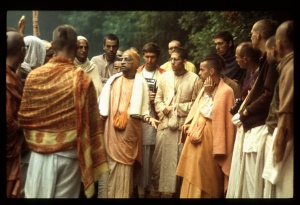CC Adi 11.20 (1975): Difference between revisions
(Vanibot #0027: CCMirror - Mirror CC's 1996 edition to form a basis for 1975) |
(Vanibot #0020: VersionCompareLinker - added a link to the Version Compare feature) |
||
| Line 2: | Line 2: | ||
<div style="float:left">'''[[Sri Caitanya-caritamrta (1975)|Śrī Caitanya-caritāmṛta (1975)]] - [[CC Adi (1975)|Ādi-līlā]] - [[CC Adi 11 (1975)|Chapter 11: The Expansions of Lord Nityānanda]]'''</div> | <div style="float:left">'''[[Sri Caitanya-caritamrta (1975)|Śrī Caitanya-caritāmṛta (1975)]] - [[CC Adi (1975)|Ādi-līlā]] - [[CC Adi 11 (1975)|Chapter 11: The Expansions of Lord Nityānanda]]'''</div> | ||
<div style="float:right">[[File:Go-previous.png|link=CC Adi 11.19 (1975)|Ādi-līlā 11.19]] '''[[CC Adi 11.19 (1975)|Ādi-līlā 11.19]] - [[CC Adi 11.21 (1975)|Ādi-līlā 11.21]]''' [[File:Go-next.png|link=CC Adi 11.21 (1975)|Ādi-līlā 11.21]]</div> | <div style="float:right">[[File:Go-previous.png|link=CC Adi 11.19 (1975)|Ādi-līlā 11.19]] '''[[CC Adi 11.19 (1975)|Ādi-līlā 11.19]] - [[CC Adi 11.21 (1975)|Ādi-līlā 11.21]]''' [[File:Go-next.png|link=CC Adi 11.21 (1975)|Ādi-līlā 11.21]]</div> | ||
{{CompareVersions|CC|Adi 11.20|CC 1975|CC 1996}} | |||
{{RandomImage}} | {{RandomImage}} | ||
==== TEXT 20 ==== | ==== TEXT 20 ==== | ||
| Line 18: | Line 17: | ||
<div class="synonyms"> | <div class="synonyms"> | ||
murāri—of the name Murāri; caitanya-dāsera—of the servant of Śrī Caitanya Mahāprabhu; alaukika—uncommon; līlā—pastimes; vyāghra—tiger; gāle—on the cheek; caḍa māre—slaps; sarpa—a snake; sane—with; khelā—playing. | |||
</div> | </div> | ||
| Line 32: | Line 31: | ||
<div class="purport"> | <div class="purport"> | ||
Murāri Caitanya dāsa was born in the village of Sar-vṛndāvana-pura, which is situated about two miles from the Galaśī station on the Burdwan line. When Murāri Caitanya dāsa came to Navadvīpa, he settled in the village of Modadruma, or Māmagāchi-grāma. At that time he became known as Śārṅga or Sāraṅga Murāri Caitanya dāsa. The descendants of his family still reside in Sarer Pāṭa. In the Caitanya-bhāgavata, Antya-līlā, Chapter Five, there is the following statement: "Murāri Caitanya dāsa had no material bodily features, for he was completely spiritual. Thus he would sometimes chase after tigers in the jungle and treat them just like cats and dogs. He would slap the cheek of a tiger and take a venomous snake on his lap. He had no fear for his external body, of which he was completely forgetful. He could spend all twenty-four hours of the day chanting the Hare Kṛṣṇa mahā-mantra or speaking about Lord Caitanya and Nityānanda. Sometimes he would remain submerged in water for two or three days, but he would feel no bodily inconvenience. Thus he behaved almost like stone or wood, but he always used his energy in chanting the Hare Kṛṣṇa mahā-mantra. No one can describe his specific characteristics, but it is understood that wherever Murāri Caitanya dāsa passed, whoever was present would be enlightened in Kṛṣṇa consciousness simply by the atmosphere he created." | |||
</div> | </div> | ||
Latest revision as of 14:30, 26 January 2020

A.C. Bhaktivedanta Swami Prabhupada
TEXT 20
- murāri-caitanya-dāsera alaukika līlā
- vyāghra-gāle caḍa māre, sarpa-sane khelā
SYNONYMS
murāri—of the name Murāri; caitanya-dāsera—of the servant of Śrī Caitanya Mahāprabhu; alaukika—uncommon; līlā—pastimes; vyāghra—tiger; gāle—on the cheek; caḍa māre—slaps; sarpa—a snake; sane—with; khelā—playing.
TRANSLATION
There were many extraordinary activities performed by Murāri, a great devotee of Lord Caitanya Mahāprabhu. Sometimes in his ecstasy he would slap the cheek of a tiger, and sometimes he would play with a venomous snake.
PURPORT
Murāri Caitanya dāsa was born in the village of Sar-vṛndāvana-pura, which is situated about two miles from the Galaśī station on the Burdwan line. When Murāri Caitanya dāsa came to Navadvīpa, he settled in the village of Modadruma, or Māmagāchi-grāma. At that time he became known as Śārṅga or Sāraṅga Murāri Caitanya dāsa. The descendants of his family still reside in Sarer Pāṭa. In the Caitanya-bhāgavata, Antya-līlā, Chapter Five, there is the following statement: "Murāri Caitanya dāsa had no material bodily features, for he was completely spiritual. Thus he would sometimes chase after tigers in the jungle and treat them just like cats and dogs. He would slap the cheek of a tiger and take a venomous snake on his lap. He had no fear for his external body, of which he was completely forgetful. He could spend all twenty-four hours of the day chanting the Hare Kṛṣṇa mahā-mantra or speaking about Lord Caitanya and Nityānanda. Sometimes he would remain submerged in water for two or three days, but he would feel no bodily inconvenience. Thus he behaved almost like stone or wood, but he always used his energy in chanting the Hare Kṛṣṇa mahā-mantra. No one can describe his specific characteristics, but it is understood that wherever Murāri Caitanya dāsa passed, whoever was present would be enlightened in Kṛṣṇa consciousness simply by the atmosphere he created."